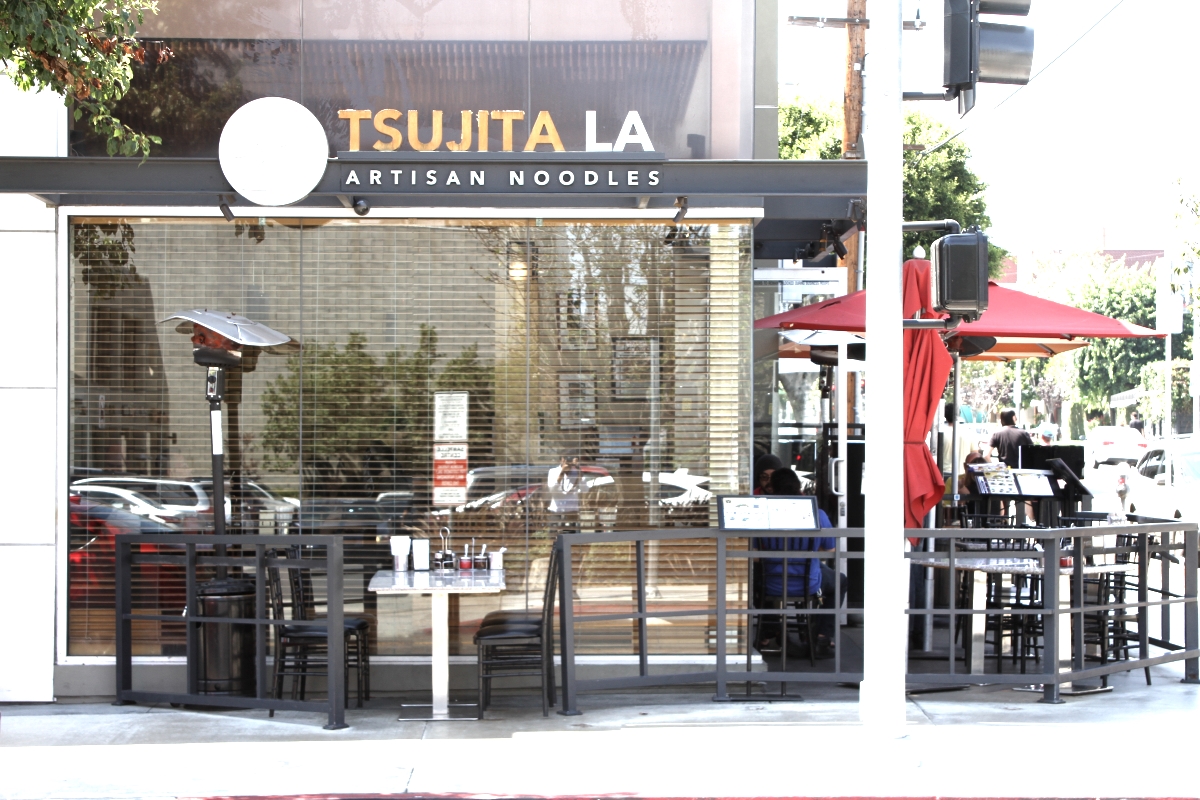Contents:
Ramen Tsujita
First things first; there are three Tsujita restaurants on Sawtelle Boulevard in West Los Angeles. There’s Sushi Tsujita, which doesn’t serve any ramen but instead, high-end sushi. Down the block from Sushi Tsujita, there’s Tsujita LA Artisan Noodles Annex, also known as the “Annex”, where you can enjoy “Jiro style” ramen which is a style of ramen with thick udon-like noodles and a soup so dense, that it’s probably the thickest and fattiest tonkotsu broth your stomach can enjoy. Then, across from the Annex, there’s Tsujita LA Artisan noodle. THIS is where it all began, changing the Los Angeles ramen landscape forever. Tsujita’s name is a regular on both national and local best ramen lists, if not usually ranked number one. Simply, Tsujita LA Artisan noodle is the king of tonkotsu ramen. We’ll refer Tsujita LA Aritisan Noodle as “Tsujita” in this article.
History
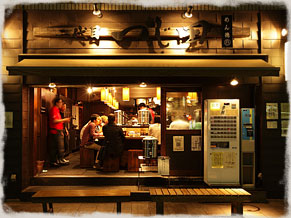
Photo credit: http://www.nidaime-tsujita.co.jp/
Highlight
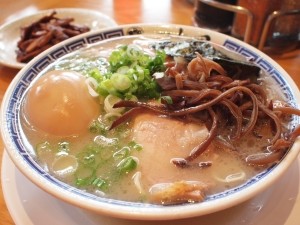
Photo Credit: Tomoko Imade Dyen (instagram.com/turningoffjapanese)
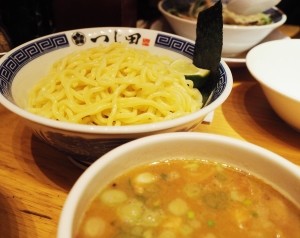
Photo Credit: Tomoko Imade Dyen (instagram.com/turningoffjapanese)
Menu
What made Tsujita famous is their tsukemen, dipping ramen. A YouTube superstar, Michelle Phan took celebrity chef Roy Choi to Tsujita to pop his tsukemen cherry on his CNN show, Street Food with Roy Choi. For the uninitiated, tsukemen is a type of ramen that comes in two separate bowls; one for noodles and the other for the dipping soup. Typically, the dipping style ramen comes with thick noodles cooked to chewy perfection, then shocked in water briefly to avoid overcooking. Tsujita does the same and serves them with a thick tonkotsu and seafood broth. Fatty tonkotsu, pork bone based soup is simmered for over 60 hours, then umami packed seafood stock is added to increase the sweetness of the broth, which is the signature of Tsujita tsukemen. When Tsujita opened in 2011, dipping style ramen was still new to the US market, especially with the pork and seafood blended soup. LA based food critic Jonathan Gold couldn’t stop raving about the new dish and immediately listed it on the coveted LA Weekly’s 99 Essential restaurants in the same year that Tsujita made its debut in the US. It’s even appeared on the list a few times since then.
So how is Tsujita’s Tonkotsu? National and local media alike, including Zagat Survey, Thrillist, Eater, and even Vogue, all agree, it is the best. Their signature broth is made with pork bones and chicken bones to achieve a thick, yet smooth and velvety texture. The noodle is thin, and served in a relatively small bowl. It is called Hakata Nagahama style which was traditionally served at fish markets to quickly satisfy hungry fishermen. Noodles are thin because thin noodles cook faster. Faster cooking time means a faster serving time. The bowl (noodle portion) is small, because if there were too much, sitting time in the broth is longer and the thin noodles would absorb the broth and lose their firmness. The soup is thicker so customers can order a noodle refill, kaedama, and enjoy a second bowl without losing the flavor. A noodle refill costs $1.50 and is a great deal considering a new bowl would cost at least $9.95.
Location
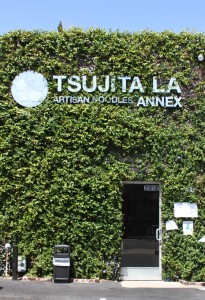
Tsujita LA Artisan Noodle is located on Sawtelle Boulevard, also known as Little Osaka, where many Japanese and Asian eateries keep popping up. It is open 11AM to 2AM (L.O.1:30AM) daily.
Navigation: 2057 Sawtelle Blvd., Los Angeles, CA 90025
Ring: 310-231-7373
Surf: tsujita-la.com
Located on the other side of Sawtelle Blvd, Annex, Tsujita LA Artisan Noodles Annex offers a completely different menu. Hours are 11AM to 12AM (L.O. 11:30PM) daily.
Navigation: 2050 Sawtelle Blvd., Los Angeles, CA 90025
Ring: 310-231-0222
Surf: tsujita-la.com
Glendale (The Americana at Brand)
Hours are 11AM to 11PM (L.O. 10:30PM) daily.
Navigation: 889 Americana way, Glendale, CA 91210
Ring: 818-553-3822
TSUJITA NJ – Kaisen Don-
Navigation: 595 River Road, Edgewater, NJ 07020
Ring: 201-945-1612
TSUJITA Hawaii
Navigation: 2250 Kalakaua Ave., Honolulu, HI 96815
Ring: 808-777-3546
If you’re planning a trip to Japan…
We highly recommend you to try Mentoku Nidaime Tsujita in Tokyo!
[Ochanomizu Kanda Shop]
Navigation: 1-4 Kanda Ogawa-cho, Chiyoda-ku, Tokyo
Nearest Station: New Ochanomizu / Ogawamachi / Awaji-cho (1 min each)
JR Ochanomizu Station / Station Kanda / Akihabara Station (8 minutes)
Hours: 11:00 to 23:30 on weekdays, 11:00 to 21:00 on weekends and holidays in Japan
[Kojimachi Shop]
Navigation: 1-4-11 Hirakawa-cho Chiyoda-ku, Tokyo
Nearest Station: Metro: Kojimachi (1 min walk)
Hours: 11:00 to 15:30, 17:00 to 21:30 on weekdays, 11:00 to 20:00 on weekends and holidays in Japan
[Iidabashi Shop]
Navigation: Iidabashi 4-8-14, Chiyoda-ku, Tokyo
Nearest Station: Iidabashi Station (2 min walk from East Exit)
Hours: 11:00 to 23:30 on weekdays, 11:00 to 21:00 on weekends and holidays in Japan
TIPS
- Expect at least a half an hour wait during lunch (11:30AM to 2PM) and dinner hours (6-9PM) and during the weekend, the wait is longer. Go right at 11AM or between the rushes to avoid a long wait. Also go with a small number in your group. Tables are limited, so if you are a group of 8, it’ll take a while, but if you are solo, you may be able to grab a counter seat with little to no wait!
- There’ll be an equally long wait at the Annex across the street. But that is the only similarities Tsujita siblings share. At Annex, it’s all about “Jiro style” ramen, thicker tonkotsu broth with broader noodles and topped with lots of veggies. This is probably one of the most lardaceous soup noodle around, and oh, so addictive. Don’t complain it’s fatty, that is Jiro style.
- Minced garlic and house made chili pepper are provided on the counter, add them little by little to find your liking.
- Metered parking is available along Sawtelle Blvd., but there’s never enough to accommodate all the hungry diners. You might need to park a few blocks away, and expect to circle around the block a couple of times to find a spot.
- You’ll notice that there are many condiments on the table. Some are familiar (red ginger and sesame seeds); and others not so much. They are all there to enhance the flavor of the already excellent Tsujita ramen noodles. For tsukemen, Tsujita offers specific way to eat it. First, eat a third of it as is, dipping noodles with the accompanying soup broth and of course, slurp. After a while, squeeze a wedge of lime on the noodles and mix, then dip the noodles into the broth. For the last third of noodles, put some shichimi (Japanese chili peppers) on the noodles, mix and dip. This way, “the taste changes dramatically with each stage” and you’ll be able to enjoy Tsujita tsukemen at its best. When you are done eating noodles, you can ask for wari, hot broth, to dilute the dipping broth, so you can actually enjoy the sipping the soup, too.
- Sesame seeds, red pickled gingers, and spicy pickled leaves are mainly for tonkotsu ramen. Just like tsukemen, you’re encouraged to eat the first couple of slurps without any additional condiments, and then later, you can gradually add them. Sesame adds nuttiness, while red pickled ginger cuts the broth’s fat with its acidity. Spicy pickled leaves make ramen spicy. It doesn’t look like very much, but spicy leaves are hot, so add sparingly until you find the perfect heat for your soup.
- There’s also a small bottle labeled “tonkotsu sauce” along with the other condiments. This is a super concentrated soup seasoning. If you feel your soup doesn’t have enough flavor, add a bit. It’s also useful when you order a kaedama, the noodle refill, because by the time you finish the first bowl, the soup may have lost a touch of saltiness.
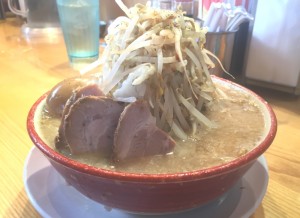
These are just guidelines, so find your own perfect combination and enjoy slurping. Remember, at ramen shops it’s encouraged, so slurp away!
*All prices, numbers and menu descriptions mentioned in the article are from the time of this article’s publishing. So keep in mind, they may have changed since then.
